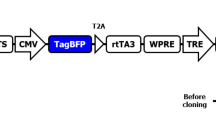Abstract
RNA interference is a powerful tool for gene functional analysis in mammals. Permanent gene suppression can be achieved by siRNAs as stem-loop precursors transcribed from RNA Pol III promoter such as H1 and U6 based on vector. This approach, however, has a major limitation: inhibition can not be controlled in a time or tissue specific manner because the RNA Pol III promoter is not time or tissue specific. To overcome these limitations, we designed a strategy that allows synthesis of small hairpin RNAs in a GFP-fused form mediated by RNA Pol II promoter CMV to efficiently and specifically knock down expression of both exogenous and endogenous genes in mammalian cells. As assayed by both fluorescence observing and quantitative RT-PCR, the protein and mRNA products of exogenous gene RFP were efficiently and specifically inhibited; quantitative RT-PCR and western blotting results respectively demonstrated that endogenous lamin B2 mRNA and protein was suppressed without global down-regulation of protein synthesis. Furthermore, GFP-fused shRNA efficacy for RNAi is dependent on target position based on this vector system. This method may provide a novel approach for the application of RNAi technology in suppressing gene expression in mammalian system.
Similar content being viewed by others
Abbreviations
- CHO cell:
-
Chinese hamster ovary cell
- CMV promoter:
-
Cytomegalovirus
- EGFP:
-
enhanced green fluorescent protein
- FBS:
-
fetal bovine serum
- Pol II:
-
RNA polymerase type II
- RFP:
-
red florescent protein
- RNAi:
-
RNA-mediated interference
- shRNA:
-
small hairpin RNA
- siRNA:
-
small interfering RNA
References
A Fire S Xu MK Montgomery SA Kostas SE Driver CC Mello (1998) Nature 391 806–811 Occurrence Handle10.1038/35888 Occurrence Handle9486653 Occurrence Handle1:CAS:528:DyaK1cXhtlCju74%3D
K Berns EM Hijmans J Mullenders T Brummelkamp A Velds M Heimerikx RM Kerkhoven M Madiredjo W Nijkamp B Weigelt R Agami W Ge G Cavet PS Linsley RL Beijersbergen R Bernards (2004) Nature 428 431–437 Occurrence Handle10.1038/nature02371 Occurrence Handle15042092 Occurrence Handle1:CAS:528:DC%2BD2cXisVGlsLY%3D
PJ Paddison JM Silva DS Conklin M Schlabach M Li S Aruleba V Balija AO Shaughnessy L Gnoj K Scobie T Westbrook M Cleary R Sachidanandam WR McCombie SJ Elledge GJ Hannon (2004) Nature 428 427–431 Occurrence Handle10.1038/nature02370 Occurrence Handle15042091 Occurrence Handle1:CAS:528:DC%2BD2cXisVGlsLk%3D
BR Williams (1997) Biochem. Soc. Trans. 25 509–513 Occurrence Handle9191145 Occurrence Handle1:CAS:528:DyaK2sXjs1ahtLo%3D
E Billy V Brondani H Zhang U Muller W Filipowicz (2001) Proc. Natl. Acad. Sci. USA 98 14428–14433 Occurrence Handle10.1073/pnas.261562698 Occurrence Handle11724966 Occurrence Handle1:CAS:528:DC%2BD3MXptFCltb8%3D
PJ Paddison AA Caudy E Bernstein GJ Hannon DS Conklin (2002) Genes Dev. 16 948–958 Occurrence Handle10.1101/gad.981002 Occurrence Handle11959843 Occurrence Handle1:CAS:528:DC%2BD38Xjt1Gktbs%3D
SM Elbashir J Harborth W Lendeckel A Yalcin K Weber T Tuschl (2001) Nature 411 494–498 Occurrence Handle10.1038/35078107 Occurrence Handle11373684 Occurrence Handle1:CAS:528:DC%2BD3MXkt1ejt7Y%3D
SM Elbashir W Lendeckel T Tuschl (2001) Genes Dev. 15 188–200 Occurrence Handle10.1101/gad.862301 Occurrence Handle11157775 Occurrence Handle1:CAS:528:DC%2BD3MXhvVOjtbg%3D
TR Brummelkamp R Bernards R Agami (2002) Science 296 550–553 Occurrence Handle10.1126/science.1068999 Occurrence Handle11910072 Occurrence Handle1:CAS:528:DC%2BD38XjtFCjtrk%3D
G Sui C Soohoo EB Affar F Gay Y Shi WC Forrester Y Shi (2002) Proc. Natl. Acad. Sci. USA 99 5515–5520 Occurrence Handle10.1073/pnas.082117599 Occurrence Handle11960009 Occurrence Handle1:CAS:528:DC%2BD38XjtFKltrg%3D
J Harborth SM Elbashir K Bechert T Tuschl K Weber (2001) J. Cell Sci. 114 4557–4565 Occurrence Handle11792820 Occurrence Handle1:CAS:528:DC%2BD38XnvFKksQ%3D%3D
T Holen M Amarzguioui MT Wiiger E Babaie H Prydz (2003) Nucleic Acids Res. 30 1757–1766
NJ Caplen S Parrish F Imani A Fire RA Morgan (2001) Proc. Natl. Acad. Sci. USA 98 9742–9747 Occurrence Handle10.1073/pnas.171251798 Occurrence Handle11481446 Occurrence Handle1:CAS:528:DC%2BD3MXmtlCmsrY%3D
D Boden O Pusch F Lee L Tucker PR Shank B Ramratnam (2003) Nucleic Acids Res. 31 5033–5038 Occurrence Handle10.1093/nar/gkg704 Occurrence Handle12930953 Occurrence Handle1:CAS:528:DC%2BD3sXmvVWrt70%3D
H Xia Q Mao HL Paulson BL Davidson (2002) Nat. Biotechnol. 20 1006–1010 Occurrence Handle10.1038/nbt739 Occurrence Handle12244328 Occurrence Handle1:CAS:528:DC%2BD38XnsVGkt74%3D
PJ Paddison AA Caudy GJ Hannon (2002) Proc. Natl. Acad. Sci. USA 99 1443–1448 Occurrence Handle10.1073/pnas.032652399 Occurrence Handle11818553 Occurrence Handle1:CAS:528:DC%2BD38Xht1ClsLo%3D
CP Paul PD Good I Winer DR Engelke (2002) Nat. Biotecluiol. 20 505–508 Occurrence Handle1:CAS:528:DC%2BD38Xjt1Kntrg%3D
X Ling F Li (2004) Biotechniques 36 450–460 Occurrence Handle15038160 Occurrence Handle1:CAS:528:DC%2BD2cXitlert7k%3D
Author information
Authors and Affiliations
Corresponding author
Additional information
Jing Yuan, Xiaobo Wang and Ning Li - These authors contributed equally to this work.
Rights and permissions
About this article
Cite this article
Yuan, J., Wang, X., Zhang, Y. et al. shRNA Transcribed by RNA Pol II Promoter Induce RNA Interference in Mammalian Cell. Mol Biol Rep 33, 43–49 (2006). https://doi.org/10.1007/s11033-005-3965-1
Accepted:
Issue Date:
DOI: https://doi.org/10.1007/s11033-005-3965-1




